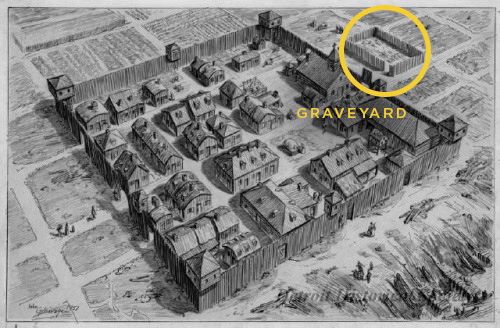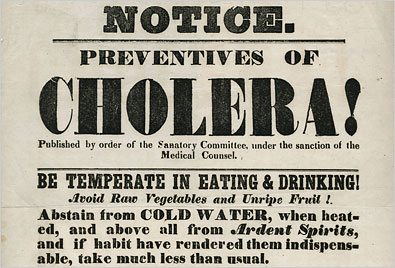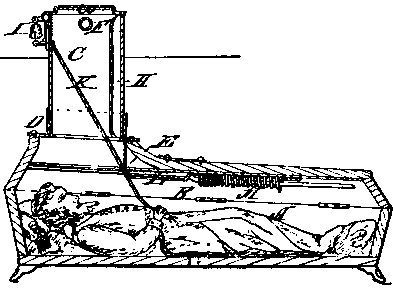CuriosiD: Where the Bodies are Buried … Beneath the Streets
Amy Miller October 29, 2015Your favorite place in Detroit just may have bones buried under it from the early days.

This week’s installment of CuriosiD investigates a question from listener John Walinske.
“Where were the dead of Detroit buried prior to the opening of Elmwood Cemetery, and are there any unmarked graves and burial grounds scattered throughout the city?” -John Walinske
The Short Answer
Yes, in fact people are buried all over. As Heidi Christein of the Archdiocese of Detroit says, “There are people under Congress, possibly under Jefferson Ave…You’re not going to find everyone.”
Researching Where the Dead are Buried

We know where at least some of the bodies are buried but Archdiocese of Detroit Archivist Heidi Christein mentions only two streets — Congress and Jefferson Ave. Now, let’s try to uncover some of the other locations.
If we start with Detroit and go back to July of 1701, Antoine Cadillac built Fort Pontchatrain du Detroit and a large French Catholic population followed. According to Christein, the first cemetery was located outside Fort Pontchatrain about where Woodward and Griswold meet. But she says not everyone is accounted, “In the very early days, people did their very best but if you died, you had to be buried and we don’t know how many people are ‘known only to God’ as the saying goes.”
According to Christein part of the problem keeping track of bodies has to do with the need to quickly bury, She says, “When someone died, they were laid out, the offices for the dead were read and the person was buried fairly promptly. If there was the ability, they would make what we would consider a box or a coffin. A lot of people were at the time probably wrapped in shrouds, some kind of material and buried that way.”
A Growing Detroit Meant Moving Lots of Bodies
The truth is, bodies were scattered throughout the area around Fort Pontchatrain at Woodward and Griswold and also at Woodward and Larned once the British arrived around 1812 and built a Protestant cemetery. As the city grew into a thriving community during the first half of the 1800’s graves were regularly disturbed during construction.
For example, says Christein the rebuilding Congress Street meant plowing through at least one graveyard. “In 1837 the current Congress Street was straightened out, the road as it was straightened, ran through what was part of a Catholic burial ground. Some of those bodies were moved but it was assumed by the Catholic Historian of Detroit, Father George Pare, that there are people somewhere under the street.”
Detroit had a Handful of Cemeteries Before Elmwood and Mt. Elliott
There were other cemeteries including what is believed to be the first city owned graveyard. In 1827 a corner of the ribbon farm owned by the Beaubien Family was purchased for cemetery land. It was equally divided for Catholics and Protestants. It was referred to as the “City Cemetery” or the Clinton Street Cemetery because it was located at Clinton and Gratiot.
Cholera Filled Up Cemetery
The first Cholera outbreak here killed a couple hundred residents which was nearly 10 percent of the population at the time. It contributed to how quickly the Clinton Street Cemetery filled up. By 1834 the city purchased another piece of land close by, at Russell and Gratiot. Over the years the Russell Street graveyard became unkept and dilapidated. It was closed in 1869 and as was the practice, of simply moving the deceased, 45-hundred graves were moved to Elmwood and Mt. Elliott cemeteries to make room for the development of the farmers market that came to be known as Eastern Market. Yes, Eastern Market is built on the site of one of Detroit’s original graveyards.
With all of its growth Detroit really needed a large space and consolidated plot for the deceased to rest in peace once and for all. Ceil Jensen co-director of the Polonica Americana Research Institute and a Genealogist says the two cemeteries that actually get the credit for being Detroit’s “first” came into existence at nearly the same time. They are right next to each other because back then Catholics and Protestants didn’t mingle much, even after death. “Elmwood was created on Jefferson near the street Mt. Elliott so that was already in place when the Irish bought the property for Mt. Elliott Cemetery. They were calling it Trinity Cemetery or the Irish Cemetery and even the French were calling it the Irish Cemetery” said Jensen.
Joseph Campau Ended Up on the Wrong Side of the Fence
The churches were so segregated when it came to burial Jensen says there’s at least one notable Detroiter who ended up on the wrong side of the fence. “You shouldn’t go against the wishes of Father Gabriel Richard. He knew that Joseph Campau was selling liquor to the Indians on Sundays and he told him to stop and the commerce did not stop so by the time it came to bury Joseph Campau, he was not allowed to be buried in the Catholic cemetery, so there is a fence, even today, that runs between Elmwood and Mt. Elliott, and so Joseph Campau is one side and his wife is on the other, and the rest of his family, around a beautiful monument in Mt. Elliott” according to Jensen
The Graveyard Shift
So we know now that there are actually bodies buried hither and thither in Detroit but what about those people who really weren’t supposed to be buried? Wayne State Department of Mortuary Science Director Mark Evely said there is no way to quantify how often it happened up often enough enough, “One of the things that they did before medical testing was perfected to determine death was they would bury someone with a bell at the top of the grave and a string or a rope that went all the way down into the grave, into the casket, so that if a person really was buried alive they could pull the string and ring the bell.” Enough people were buried alive to coin a phrase “That’s where the term graveyard shift comes from, someone had to be there to listen for the bell” said Jensen.
Thanks to Detroit Archivist Heidi Christein, Wayne State Department of Mortuary Science Director Mark Evely, and Richard Bak, author of “Boneyards, Detroit Under Ground” for a great resource.


